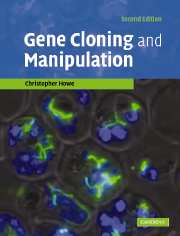Book contents
- Frontmatter
- Contents
- Preface to first edition
- Preface to second edition
- Chapter 1 The tools for the job
- Chapter 2 Polymerase chain reaction
- Chapter 3 Simple cloning
- Chapter 4 Other vector systems for E. coli
- Chapter 5 Making libraries
- Chapter 6 Screening libraries
- Chapter 7 Modification and mutagenesis
- Chapter 8 Use of cloned DNA
- Chapter 9 Using other organisms
- Chapter 10 Examples
- References
- Index
Chapter 7 - Modification and mutagenesis
Published online by Cambridge University Press: 05 June 2012
- Frontmatter
- Contents
- Preface to first edition
- Preface to second edition
- Chapter 1 The tools for the job
- Chapter 2 Polymerase chain reaction
- Chapter 3 Simple cloning
- Chapter 4 Other vector systems for E. coli
- Chapter 5 Making libraries
- Chapter 6 Screening libraries
- Chapter 7 Modification and mutagenesis
- Chapter 8 Use of cloned DNA
- Chapter 9 Using other organisms
- Chapter 10 Examples
- References
- Index
Summary
Introduction
So far, we have seen how to clone particular sequences and identify them. In Chapter 8 we will look at how these clones can be put to use directly at the DNA level or to direct the synthesis of RNA or protein. However, it is often the case that we need to modify sequences before using them. Here are just three of the many situations in which we may need to do this:
(a) We are trying to identify promoters and regulatory sequences, and need to make a mutation in a putative promoter or regulatory sequence to see whether that actually affects the efficiency of transcription initiation.
(b) We are interested in how the primary and higher order structures of a protein determine its function. It might, therefore, be necessary to modify the codon for an amino acid we believe to be at the active site of an enzyme and then assess the effects of that change on catalytic activity. Directed alteration of particular parts of proteins as a way of probing the relationship between structure and function or altering the function in a controlled way is often termed protein engineering.
(c) Genes are often cloned without our fully understanding the role that the proteins they encode have in the cell. Assessing that role may be possible by inactivating the endogenous gene in an organism to generate a mutant strain. This approach is often called reverse genetics, to emphasize the contrast with the traditional approach whereby a strain carrying a mutation with specific effects is characterized first and the relevant gene cloned and analysed subsequently.
- Type
- Chapter
- Information
- Gene Cloning and Manipulation , pp. 143 - 161Publisher: Cambridge University PressPrint publication year: 2007
- 1
- Cited by



